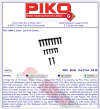notofthiscenturyTim
Registered
Does anyone know the size of the four screws needed to fit a speaker in a Piko BR 194 on the mounting provided on the base of the loco?
The speaker is a Visaton FRS 7 which is the same as the one sold as part of the official Piko sound conversion kit. I know that screws are included in that kit but I haven't been able to find out what size they are. They look like thread forming screws designed for thermoplastics.
The speaker is a Visaton FRS 7 which is the same as the one sold as part of the official Piko sound conversion kit. I know that screws are included in that kit but I haven't been able to find out what size they are. They look like thread forming screws designed for thermoplastics.





